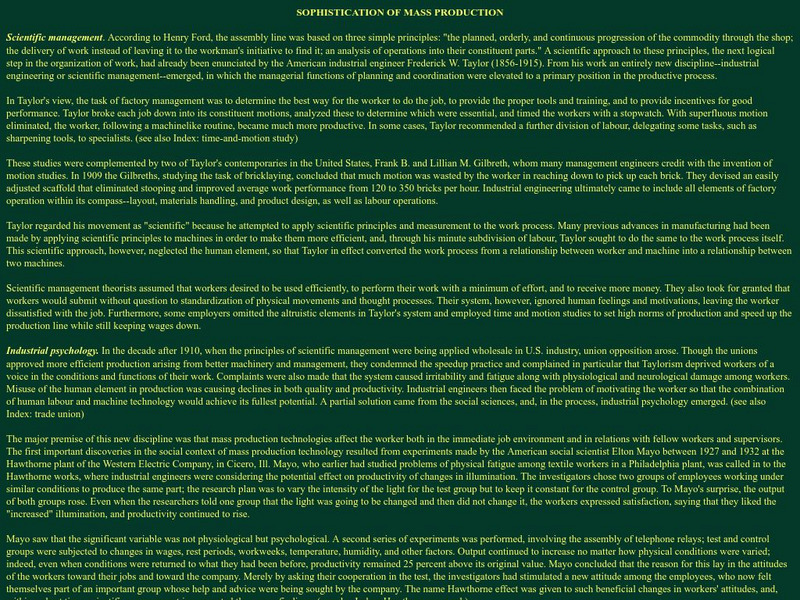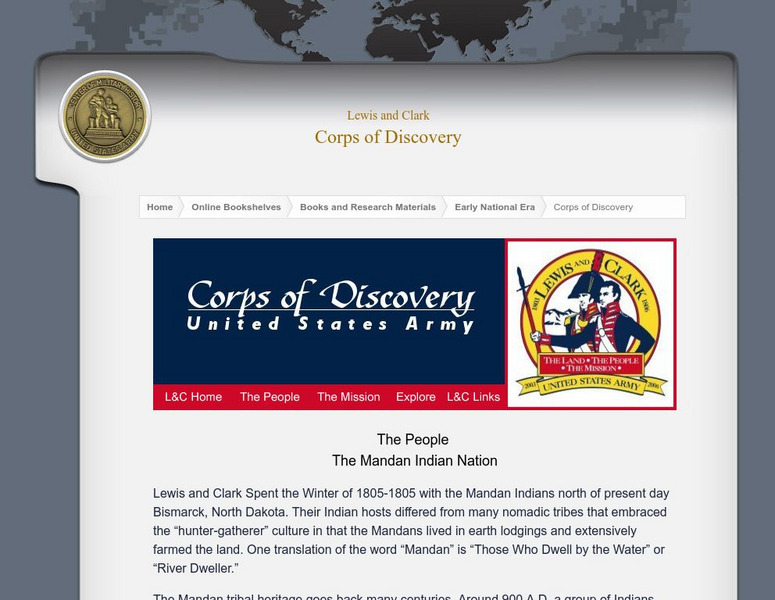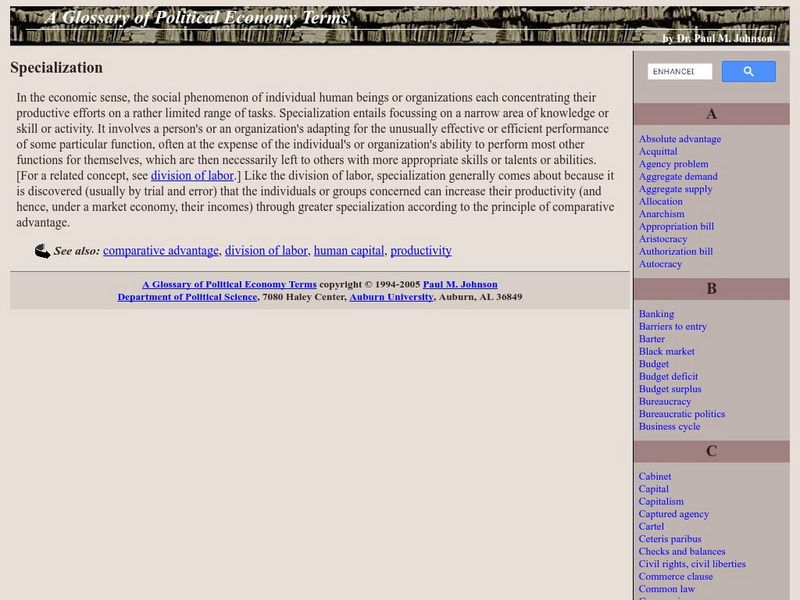Federal Reserve Bank
Ten Mile Day
Get your class working on the railroad with this detailed and interactive lesson. After reading and discussing Ten Mile Day, learners explore division of labor, human capital, and productivity with a hands-on group activity in which they...
Internet History Sourcebooks Project
Fordham University: Modern History Sourcebook: The Wealth of Nations
Book 1, Chapters 1-11 from Adam Smith's The Wealth Of Nations dealing with the division of labor.
University of Washington
Complex Dynamics in a Model of Economic Specialization [Pdf]
This article provides an in-depth study of how and why there is specialization by workers in an economy, with considerable attention given to the philosophies of Adam Smith.
Other
Management Control: Scientific Management
A look at the ideas of scientific management in mass producing products in the early 20th century. Includes ideas of Henry Ford, Frederick Taylor, and Elton Mayo.
Other
Introduction to Anthropology: Taylorism and Fordism
Read about the precepts of Frederick Taylor and Henry Ford in their applications of scientific business management that improved productivity and increased output of consumer goods.
Council for Economic Education
Econ Ed Link: Old Business, New Business
For this lesson learners are introduced to several businesses from the past. They see that, while the names for these businesses are different, many of the elements of that job are seen in occupations today. The web site, "Business...
Council for Economic Education
Econ Ed Link: Dog Gone Job!
Dog Gone Job! demonstrates how job specialization increases productivity.
Council for Economic Education
Econ Ed Link: Productivity Video and Quiz
This video teaches the concept of Productivity, which is measured as the quantity of output per unit of input. Watch the brief video and take the interactive quiz to assess what you have learned. [1.47]
Federal Reserve Bank
Federal Reserve Bank of Philadelphia: Ten Mile Day [Pdf]
Using the book, Ten Mile Day, by Mary Ann Fraser, this lesson helps children understand division of labor, competition, and incentives in the workplace.
Council for Economic Education
Econedlink: Trade, Exchange and Interdependence
This video teaches the concept of Trade, Exchange and Interdependence. People do not make everything that they and their family use: that is, they do not grow all their own food, sew their own clothes, build their own house and provide...
Council for Economic Education
Econ Ed Link: Lean on Me We Depend on Each Other!
The purpose of this activity is to demonstrate that the production of most goods can be broken down into a number of specific tasks (division of labor), with each of these tasks assigned to specific workers (specialization.)
Council for Economic Education
Econ Ed Link: Banks, Bankers, Banking
Students will demonstrate understanding of the processes associated with banking by role-playing as customers, tellers, and guards.
Council for Economic Education
Econ Ed Link: Henry Ford and the Model T: A Case Study in Productivity (Part 1)
Henry Ford's use of mass production strategies to manufacture the Model T revolutionized industrial manufacturing. This 3-part learning unit provides students with the story of Henry Ford and the Model T from an economics perspective....
Council for Economic Education
Econ Ed Link: Hawaiian Economics: Barter for Fish & Poi
In ancient Hawaii, chiefs managed the economy by creating a land division system, the Ahupua'a, which divided the islands into pie slice shapes. Each Ahupua'a covered the three main regions of the islands: the mountains, the valleys, and...
Khan Academy
Khan Academy: What Is Urban Growth?
How were cities formed? This article explains the formation of cities starting from the neolithic revolution to current times. It addresses such topics as urbanization, suburban sprawl, and urban growth models.
American Forum for Global Education
American Forum for Global Education: A Simple Chocolate Bar
This site is provided for by the American Forum for Global Education. Using a candy bar as a theme, students will explore their common link to other "systems on a global scale." Mutual dependence is a key concept taught in this lesson...
US Army Center
U.s. Army Center of Military History: Lewis and Clark: Corps of Discovery: The Mandan Indian Nation
Find a description of the Mandan culture, housing, and daily way of life. Included are photographs of Mandan villages and houses.
Other
Principia Cybernetica Project: Insect Societies
A description of the evolution of the caste differentiation in insect colonies.
Auburn University
Auburn University: Glossary of Political Economy Terms: Specialization
Dr. Johnson defines the term "specialization" and reasons for its development in our economy.
Massachusetts Institute of Technology
Mit: Inventor of the Week: Henry Ford
This site from MIT Invention Dimension is a brief profile of Henry Ford focusing on the Assembly Line.




![Complex Dynamics in a Model of Economic Specialization [Pdf] Activity Complex Dynamics in a Model of Economic Specialization [Pdf] Activity](https://d15y2dacu3jp90.cloudfront.net/images/attachment_defaults/resource/large/FPO-knovation.png)









